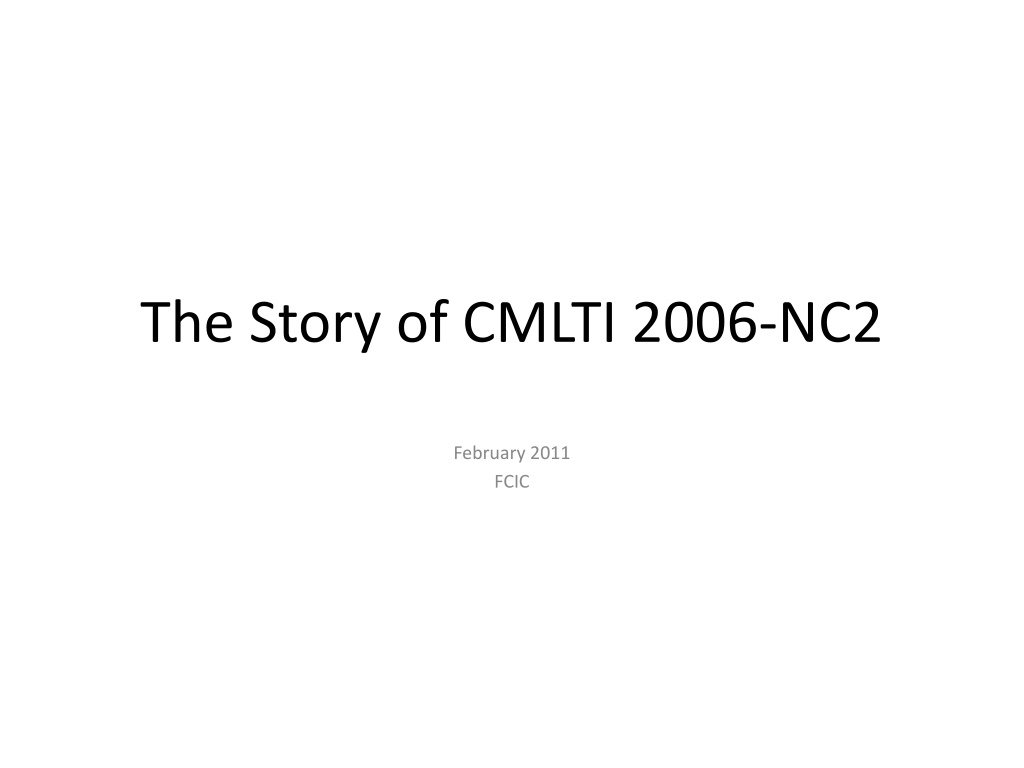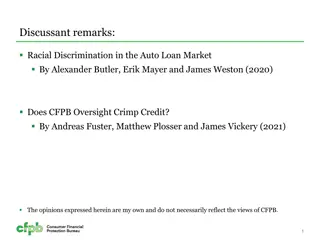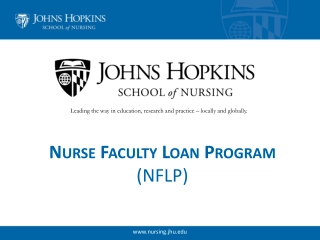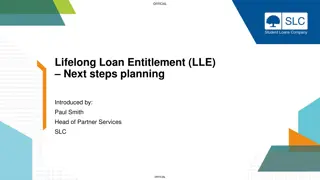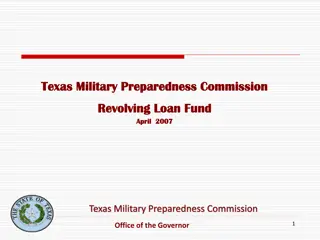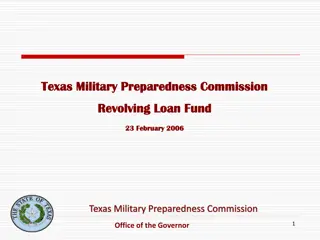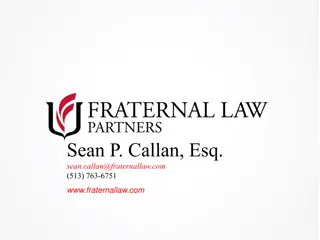The Story of CMLTI 2006-NC2 Loan Purchase Deal
Citigroup agreed to purchase approximately $1 billion in loans from New Century in 2006. The deal involved two pools of loans, with potential legal issues leading to some loans being pulled from the pool. Due diligence was performed by 406 Partners, resulting in more than 200 loans being removed. Issues arose during the closing as violations of the initial agreement were discovered, leading to adjustments in the final trade summary.
Download Presentation

Please find below an Image/Link to download the presentation.
The content on the website is provided AS IS for your information and personal use only. It may not be sold, licensed, or shared on other websites without obtaining consent from the author. Download presentation by click this link. If you encounter any issues during the download, it is possible that the publisher has removed the file from their server.
E N D
Presentation Transcript
The Story of CMLTI 2006-NC2 February 2011 FCIC
On June 9, 2006, Citigroup agreed to purchase approximately $1 billion in loans from New Century. The characteristics of the loans to be purchased were spelled out at that time, as was the price: Citi would pay $102.55 for every $100 in mortgage balance. The trade ticket and stip (stipulation) sheet summarize the details of the deal and the pool that would be created. Tab 1: Citi Commitment Letter Source: New Century Bankruptcy Trustee Tab 2: Trade ticket Source: New Century Bankruptcy Trustee Tab 3: Stip Sheet Source: New Century Bankruptcy Trustee
The deal would involve two pools of loans one that conformed to the GSE limits and one that did not. On July 20, New Century sent Citi a description of the loans in the first pool. A week later they sent a description of the two pools combined. Tab 4: E-mails regarding the deal Source: New Century Bankruptcy Trustee
Through late July and August, one or two at a time, loans were pulled from the pool for legal issues, because they had been sold into other pools, or for other reasons. Tab 5: E-mails Source: New Century Bankruptcy Trustee
Due diligence for this deal was performed by 406 Partners, LLC. The review was to take place at New Century between 7/31 and 8/11. 406 Partners sent New Century the list of loans they wanted to review as per the initial sale agreement, 25% of the loans would be sampled for credit review. In the end, more than 200 loans were removed from the pool. Tab 6: E-mail from 406 to New Century Source: New Century Bankruptcy Trustee Tab 7: Spreadsheets showing results of the review Source: Citigroup Note: these fields are included in final data file
As the loan purchase was closing on August 29th, New Century sent a final list of the 4,521 loans they were selling. Citi personnel saw violations of the initial agreement: 14 NINA loans (no income, no assets) and too few loans with prepayment penalties. They forced New Century to keep the 14 NINA loans and bargained the price down to account for the other problems. Tab 8: E-mails detailing the problems Source: New Century Bankruptcy Trustee Tab 9: Final trade summary showing 4507 loans Source: New Century Bankruptcy Trustee
With the loans settled, $978.6 million had to be moved from Citigroup to New Century. These loans were funded by a series of warehouse lines with individual loans serving as the collateral. New Century sent Citi the wire instructions; Citi sent the money, and the individual lenders released the loans as they were paid back. Tab 10: Wire instructions Source: New Century Bankruptcy Trustee Tab 11: Tracking e-mail from Citi to NC Source: New Century Bankruptcy Trustee Tab 12: Release letters Source: New Century Bankruptcy Trustee
Citi then began to market the various tranches of this mortgage-backed security. Tab 13: Prospectus (Citi) Tab 14: Fannie Term Sheet
To sell the bonds, Citi needed the rating agencies to rate them. On September 11, S&P ran its model and confirmed the ratings of the individual tranches. When the deal was priced on September 12, the interest rates on some of the bonds were slightly different than those S&P had originally modeled. The final models were run on September 26 as the deal was closing. S&P sent the final ratings letter to Citi. For rating this deal, S&P earned $135,000. (A second agency, Moody s, earned $208,000.) Tab 15: Moody s Invoice Tab 15b: S&P Invoice Tab 16a: S&P ratings letter to Citi Tab 16b: S&P Final Deal Summary Tab 16c: S&P ratings summary doc Tab 16d: S&P pre-closing checklist Tab 16e: True sale letter Tab 17a: Model runs 9-11 Tab 17b: Model runs 9-26 Tab 17c: Waterfall (from runs above) Tab 18: Moody s rating memo
When the deal closed on September 26 , Citi had lined up investors around the world. Banks and funds in England, Germany, Italy, France, and China all bought pieces of the deal. Some investors merit special mention: Fannie Mae bought the A1 tranche Cheyne Finance, one of the first SIVs to collapse, bought the M1 tranche Parvest Euribor, one of the hedge funds owned by Paribas that froze redemptions, bought the M2 tranche Bear Stearns Asset Management and JP Morgan Chase s securities lending group were also investors Tab 20: Investor lists Source: Citi
Most of the mezzanine tranches were bought by CDOs, including the cash deal Kleros Real Estate III Tab 21: Docs regarding some of the CDOs that bought the deal
In addition to cash deals, a number of synthetic/hybrid CDOs held credit default swaps (CDS) referencing the lower-rated tranches of this deal. These included Volans Funding 2007-1, Glacier Funding CDO V, and Auriga CDO Tab 22: Offering circulars and pitch books for some of the synthetic CDOs that referenced the deal.
The bonds would perform as long as the mortgages did. The following maps show that performance over time. (Graphic to show performance of loans and bonds)
The performance of CMLTI 2006-NC2 can be traced in parallel with a timeline of the crisis: July 10, 2007: Moody s downgraded 399 residential mortgage-backed securities the lower three tranches of this deal were among these downgrades August 9, 2007: BNP Paribas froze redemptions August 28, 2007: Cheyne Finance announced funding trouble October 11.2007: More mass downgrades issued, including tranches of this deal .
By 2008, foreclosures were rampant among these loans and loan modifications had begun. The lower- rated tranches were all wiped out. The A1 and some of the A2s were still performing. By late 2009, all the tranches had been downgraded.
By September 2010, many borrowers whose loans were included in this securitization had moved or refinanced their mortgages; by that point, 1,917 had entered foreclosure (mostly in Florida and California), and 729 had started loan modifications. Of the 1,715 loans still active loans, 579 were seriously past due in their payments or currently in foreclosure. Data file to be posted on website including origination details for all 4,499 loans, along with monthly performance data
